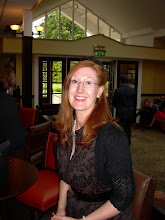After visiting the Laura Knight exhibition in Nottingham earlier this year, I’ve been looking forward to this – and it didn’t disappoint. The title of the exhibition is taken from the title of Laura Knight’s autobiography, and nicely suits the works included. Incidentally, this exhibition is part of the Campaign for Drawing’s annual "Big Draw", to encourage everyone to pick up a pencil, and there was paper and pencils all around the exhibition for anyone who felt so inclined.
Many of the drawings in the early part of the exhibition were by the Birmingham-born Walter Langley, whose Newlyn School drawings display wonderful local flavour and attention to character. "Study for a Daydream" (1884), a portrait of a distracted young girl, had perfect, dreamy eyes, ignoring the viewer. The grainy effects of his lines are put to good use in images of local scenes, and characters such as elderly, weatherbeaten fishermen, whose relationship with the sea is etched in every line of their faces. Langley was clearly particularly interested in the local habitat, exploring the domestic side-effects of the local fishing trade such as wives left at home as their husbands were on the sea, widows and children portrayed inside the bare cottages. The tragedy of life in the area is particularly well-depicted in "Among the Missing", where a woman, supported by an older woman, reads her husband’s name on the list of the dead. Other pictures such as "Alone" show the desolation after the death of a husband, while "Widowed" shows the young widow cared for by her mother.
The sea provides metaphors for other aspects of life, particularly death. In William Holt Yates Titcomb’s "Piloting her Home", 1893, an old woman lies in bed, awaiting death with a radiance of divine love and peace on her face, while those around her raise their hands to God. Similarly, Langley’s Study for "The Seas are Quiet" shows an elderly lady lying on pillows, smiling, with the turbulence of her life past.
One of my favourite pictures here was Stanhope Alexander Forbes’s "The Cello Player" – one can almost hear the sonorous music in this dark and thoughtful study. I found this drawing to be more like his wife’s than many of his are: Elizabeth Adela Forbes’s drawings of "The Bakehouse" and "The Cornish Pasty" depict dark interiors, with only the figure in action lit for the viewer, suggested a theatricality in the ‘staging’ of the drawing. I’d not seen her illustrations for King Arthur’s Wood
 (1904) before, but was struck by their delightful medievalism – the wonderful texture of her other drawings is here used to evoke myth and enchantment. I was also interested in Thomas Cooper Gotch’s Pre-Raphaelite-esque cartoons for "A Mother Enthroned", in which a mother of many daughters is clearly paralleled to the Virgin Mary. (see painting, left)
(1904) before, but was struck by their delightful medievalism – the wonderful texture of her other drawings is here used to evoke myth and enchantment. I was also interested in Thomas Cooper Gotch’s Pre-Raphaelite-esque cartoons for "A Mother Enthroned", in which a mother of many daughters is clearly paralleled to the Virgin Mary. (see painting, left)Harold Knight didn’t get much of a look-in here, with just a few portraits of almost photographic detail; but beside those of his wife Dame Laura they seem to lack conviction, while her portraits of young women – "Seated Girl Reading", 1892, "Self Portrait", etc, have so much life, feeling and movement even in repose. Knight seems to have a gift, in her portraits, for convincing the viewer of the character of the sitter with just a few lines. I was caught by "Madonna", 1923 – very much of its time, this seems to be an early echo of the later theatrical works by Knight, despite the beatific expression on the Madonna’s face. Few of the works here are theatrical, though there is a wonderful sketch of "George Bernard Shaw Posing for his Bust", but there are some amazing leaves from her sketchbook, which give an excellent insight into the clean lines she uses for movement and grace in the dancers she later painted – especially the ballerinas’ arms, so hard to capture correctly. I also rather liked "Country Girls" (1926) – especially appealing, I think: three girls seated together, side on; one looks anxiously – or is it slyly? – at the viewer, while the other two gaze unconcernedly into the distance. It’s stylised and of the period, yet still seems so natural.
Somehow I find going to an exhibition of drawings a very different experience to one with paintings – less colour, less large, dramatic paintings, more shadows and darkly intense, small pictures. And there are some perfect gems here.











No comments:
Post a Comment